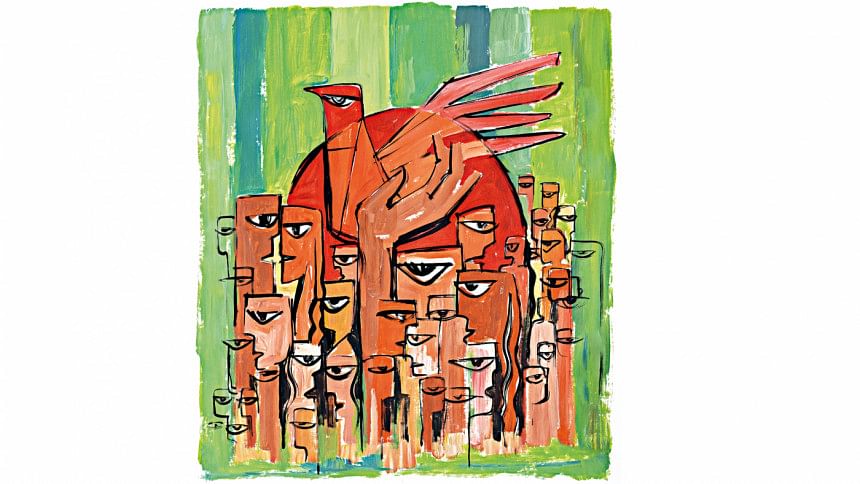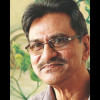‘FOR YOUR SAKE, O FREEDOM’ 1971 and Bangladeshi poetry

Bangladeshi poetry has always been sensitive to socio-political issues and public themes. In discussing the poetic response to the Liberation War, therefore, it is useful to start with the broad historical background, move on to the literary tradition, and then consider the poetry itself.
The immediate historical background is the movement for provincial autonomy, out of which came the independence struggle. Further back is the Language Movement, which exposed a fissure in the national ethos of Pakistan. Ironically, Bangalee Muslims had been among the most ardent supporters of the Pakistan movement. Their disillusionment, when it came, was understandably all the more intense and bitter.
A deeper historical root of Bangladesh lies in the short-lived Bengal partition of 1905; for six years it put on the map the province of East Bengal and Assam, with Dhaka as its capital. Though opposed by the Hindus, the partition was welcomed by a majority of the region's Muslims. One may also partially identify an antecedent of Bangladesh in the abortive move in 1947 by an alliance of Hindu and Muslim leaders—including Huseyn Shaheed Suhrawardy, Abul Hashem, Sarat Chandra Bose, and Kiran Shankar Roy—to have an independent "Free State of Bengal".
There is another, much older, historical circumstance that has a bearing on the Bangladesh movement.
In the Sepoy Uprising of 1857, the rebels belonged to the Bengal Army, recruited mainly from the Gangetic plains, while the Gurkha, Sikh, Punjabi Muslim, Jat, Dogra, and Pathan soldiers remained loyal to the British. After the rebellion was quelled, the British propounded the theory of martial and non-martial races, placing under the former category all the ethnic groups that had been loyal to them. Henceforth their Indian soldiers were recruited from among them, while the old catchment area of the Gangetic plain was deemed to be peopled by non-martial types. The martial races were supposed to be good fighters, loyal and obedient, albeit a bit obtuse; and the non-martial ones clever but feckless and duplicitous.
Such racial stereotyping survived as an unfortunate legacy of the Raj, and poisoned relations between West Pakistanis and the Bangalees of East Bengal. The "martial" Punjabi took it as his right to dominate the "non-martial" Bangalee. When the Pakistan Army launched its genocidal onslaught, little did it expect an effective popular resistance. The Bangalee freedom fighters not only helped liberate their country but also removed the mind-forged manacles of racial stereotypes. Bangladeshis could henceforth project a self-image free of an inferiority complex.
*
With the partition of 1947, Dhaka emerged as a significant literary-cultural hub. There were a few traditionalist poets imbued with the Islamic ideology of the Pakistan movement, but they were quickly put in the shade by a new generation of modernists whose distinctive characteristic was a capacity for aestheticist introspection that coexisted with a lively interest in public events. The killing of five Language Movement demonstrators on February 21, 1952 elicited an immediate response from them. The tragic event has ever since exercised the imagination of our poets, inspiring protest poetry as well as meditative verse.
Bangla was recognised as one of the national languages of Pakistan, but there were other sources of discontent. Democracy had been put on hold, and the economic exploitation of East Pakistan continued apace. A pro-democracy movement gathered momentum in the late 1960s, inspiring a spate of political poetry.
Shamsur Rahman, the country's leading modern poet, climbed down from the ivory tower to write poems like "Hartal", "Asader Shirt" (the eponymous Asad being a martyr of the pro-democracy agitation), "Safed Panjabi" ("White Kurta", a lively portrait of Bhasani, whom Time magazine, if I remember rightly, had dubbed the "red maulana"). A younger poet, Nirmalendu Goon, wrote the highly popular "Hulia" ("Arrest Warrant").
The struggle for democracy and, for some, for socialism, and the poetry that emerged from it, had international analogues: protests against the Vietnam War, the Campaign for Nuclear Disarmament, student uprisings, notably in Paris in May 1968, all of which had literary repercussions. Protest poets like Adrian Mitchell and Christopher Logue and the Beats enjoyed worldwide readership; poets in Bangladesh could rightly feel they were part of a global trend.
Then came the crackdown of March 25, 1971, plunging 70 million people into a cauldron of terror, panic, anxiety, but also strengthening a collective resolve to resist and overcome. Such powerful emotions had to result in a large body of poetry.
But there was a catch. The ruthlessness of the military crackdown, and the spread throughout the land of armed conflict between freedom fighters and occupation forces, meant the suspension of many normal activities. The creative imagination was constricted by anxiety. And even if it found expression somehow, the process of cultural production was blocked. Liberation War poetry consequently saw the light of print after victory was achieved.
*
The most magisterial poetic take on the independence war is undoubtedly Shamsur Rahman's collection "Bondi Shibir Theke" ("From the Concentration Camp"). Rahman himself has given us the backstory in a moving preface to the definitive edition of the book (Dhaka, 1997). After the crackdown, he and his family moved out of Dhaka city and sought refuge in his ancestral village in Narsingdi for a month and a half. He wrote two of his best-known poems there: "Tomake Pawar Jonyo, hey Swadhinata" ("For Your Sake, O Freedom") and "Swadhinata Tumi" ("Freedom, You Are"). He started writing poems in a diary, and secreted it in all sorts of odd places, just in case men in uniform came and conducted a search. Only his wife, a few close friends and a few freedom fighters knew of this. Returning to his house in Dhaka in mid-May, Rahman found the yard overgrown with grass and weeds, and an insouciant white cat that had made its home there; the animal's composure gave much needed reassurance amidst the tension and terror, the daily arrests and murders, the ominous noises of military vehicles, and the sound of boots. Going to work, reading, writing, all seemed meaningless.
One was an exile in one's own home. Under such dire conditions, Rahman composed the 38 poems of his book.
The manuscript was smuggled through Mukti Bahini channels to Kolkata, where the critic Abu Sayeed Ayub published some of the poems in Desh. For obvious security reasons Ayub chose a nom de plume for the poet:
Majlum Adib, which, significantly, means "persecuted writer". After Bangladesh achieved independence, the first edition of Bondi Shibir Theke, comprising a selection of the poems, was published in Kolkata in 1972. The definitive edition later published in Bangladesh gives a richer and more varied picture of wartime Bangladesh, and repays careful study.
Several poems depict the desperate situation of those who were stuck in a city under occupation. "Pather Kukur" ("Stray Dog"), for instance, contrasts the anxiety-ridden people in a house who sit in "funereal silence" with the carefree stray dog that roams outside and charges after an army Jeep. The speaker can only wish he "were at least that stray dog". There is a realistic account of the harassment people faced in the streets alongside a satirical portrait of Yahya Khan ("Pratyahik": "Quotidian"); an elegiac description of a shell-shattered house ("Ekhane Dorja Chhilo": "I Remember", in my translation); and in a laudable exercise in empathy, a monologue of a fatally wounded Pakistani soldier who realises that he has been used as an instrument of tyranny ("Jonoiko Pathan Shoinik": "A Pathan Soldier").
While Shamsur Rahman was the most prolific of our major poets, his younger contemporary Shaheed Quaderi was the opposite. Still, his small but distinguished output includes five memorable poems relating to the war. In "Kobita, Akshyam Astra Amar" ("Poetry, My Useless Weapon") he desperately exhorts his lines to "roar at least once like field guns". "Nishidhyo Journal Theke" ("From a Forbidden Journal") depicts a devastated Dhaka city and a martyred boy, yet ends on an affirmative note. "Pakhira Signal Dai" ("Signalling Birds", in my translation) celebrates the freedom of the birds with "ID-less wings" as they soar above the occupied city. "Blackouter Purnimai" ("Blackout on a Full Moon") looks forward to the return of those who have become refugees. "Swadhinatar Shahar" ("The City after Liberation") presents a perceptive and melancholy picture of the ambiguous gifts brought by independence.
Muktijuddher Kabita ("Poems of the Liberation War"), edited by the late lamented litterateur Abul Hasanat, showcases 270 poems by 126 poets. It gives a fair impression of our Liberation War poetry, its recurrent themes and tropes, its tonal range, its prosodic predilections. The poets range from Jasimuddin, then the doyen of Bangladeshi poets, to those who were young only the other day. The veteran pastoral poet's robust rhymed couplets in the poem "Muktijoddha" ("Freedom Fighter") is a stirring and confident monologue that convincingly overturns the myth of the non-martial Bangalee. So do numerous poems in this anthology; collectively they become a chorus of heroic national self-affirmation.
The reader will find many such poems; here are a few more that arrested my attention: Ahsan Habib's "Search", Syed Shamsul Haque's clever pattern poems, "Guerilla" and "Bostur Akar" ("The Shape of Things"), Fazal Shahabuddin's "Muktijoddhake" ("To a Freedom Fighter"), Manzur-e-Mowla's "Hey Bir" ("O Hero"), Khondkar Ashraf Hussein's "Bowsi Bridge".
Faruk Alamgir's "Modhynanney Muktijoddhake" ("To a Freedom Fighter at Midday") adds a realistic twist by ending on the note of disillusionment that overtook many freedom fighters after independence. Unsurprisingly, several poems invoke the leader of the independence struggle, for instance, Belal Chowdhury's "Abohoman Bangla o Bangalir" ("Of Eternal Bengal and Bangalees"), which ends by mentioning "An imperishable red waterlily/ Bangabandhu Sheikh Mujibur Rahman"; his historic speech of March 7, 1971 is given effective mythopoeic treatment in Nirmalendu Goon's "Swadhinata ei shobdota amader ki bhabe holo" ("How we gained possession of the word freedom").
What about English language poetry and the war? Mention must be made of Razia Khan's title poem of her first collection, "Argus under Anaesthesia" and "God in the Goblet", from the same collection. The first is a heartfelt response to the crackdown, the second to the massacre of intellectuals. I have published three poems about the war, "Crackdown" and "Bangladesh 1971", written just after independence, and a third looking back on that fateful year. I wish I had written more. I will conclude with a salute to Allen Ginsberg, whose "September on Jessore Road" remains unmatched as an evocation of the desolation of the refugee trail.
I do not know if there have been any critical studies of the poetry of our independence war. It would be a worthwhile subject for a PhD; I hope young researchers will take note.
Kaiser Haq is a Bangladeshi poet, translator, essayist, critic, and academic. He is a professor at the Department of English & Humanities, ULAB.

 For all latest news, follow The Daily Star's Google News channel.
For all latest news, follow The Daily Star's Google News channel. 







Comments